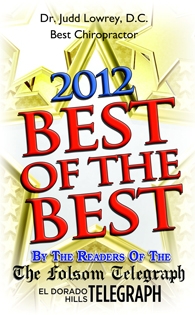Feel Better in 2012: Strategies for Health and Wellness in the New Year!
Thursday, January 19th, 2012 The New Year is here, and thoughts naturally turn to resolutions and self-improvement. For some this means curtailing high fat foods and returning to the gym. For others, January is the time to start a comprehensive wellness plan to have a healthy, pain-free year.
The New Year is here, and thoughts naturally turn to resolutions and self-improvement. For some this means curtailing high fat foods and returning to the gym. For others, January is the time to start a comprehensive wellness plan to have a healthy, pain-free year.
Chiropractic care can be a vital component to a healthy lifestyle along with the following five New Year’s strategies that will enable you to reduce the chance of painful injuries.
1. Don’t carry a heavy briefcase, backpack, or purse with the strap over one shoulder, unless placing the strap over your head on the side opposite the bag. Carrying a bag on one shoulder places uneven weight on one side of your body which can cause both back and shoulder pain.
2. Make an effort to keep moving while at work and take periodic stretch breaks.
3. Don’t lift heavy objects over your head which can strain muscles and damage nerves.
4. Don’t turn your torso while lifting heavy objects.
5. Don’t consistently cross the same leg over the other which can lead to spine misalignment.
By taking these five steps, you can go a long way towards preventing back, shoulder, and neck pain and injury. This translates directly into having to take less pain medication.
The reality is that over the counter nonsteroidal anti-inflammatory drugs (NSAIDs) such as acetaminophen and ibuprofen can negatively affect your long-term health in a variety of ways.
NSAIDs are a leading cause of stomach ulcers and gastric bleeds. This is particularly true for certain age groups.
They can damage kidneys. According to a New England Journal of Medicine article, up to 10% of all kidney failure was a result of the abuse of NSAIDs such as Advil and Tylenol.
And, the biggest risk for those taking large doses of pain medications is liver damage. This is especially true for those consuming large quantities of acetaminophen. Unfortunately, about 1/3 of the individuals who overdose on acetaminophen didn’t understand the risks before taking more than the recommended amount.
Finally, rebound pain is a common, yet often under-reported symptom of taking NSAIDs. The nervous system continues to generate pain when an individual takes these over-the-counter medications. Thus, pain medications may even contribute to someone getting hooked or addicted.
While there are situations when pain medication makes sense, it’s important to understand the risks and know the alternatives. One alternative to managing pain and taking medication is chiropractic care. At Lowrey Chiropractic, we have the training and experience to manage both acute and chronic pain. If you’re ready to start 2012 out right – free from pain, give us a call today. You’ll be glad that you did!







